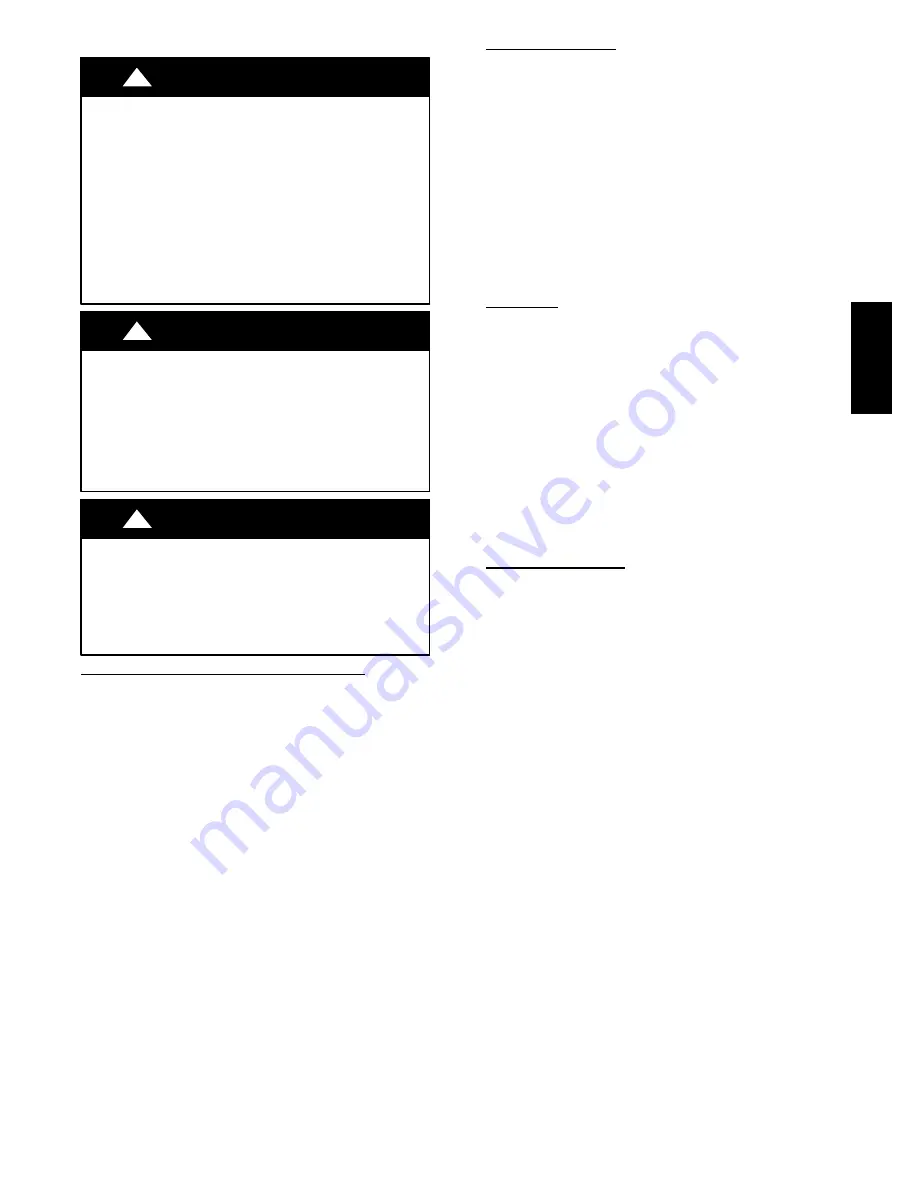
9
STEP 10
—
Start--Up
CAUTION
!
UNIT OPERATION AND SAFETY HAZARD
Failure to follow this caution may result in minor personal
injury, equipment damage or improper operation.
To prevent compressor damage or personal injury, observe the
following:
S
Do not overcharge system with refrigerant.
S
Do not operate unit in a vacuum or at negative pressure.
S
Do not disable low pressure switch in scroll compressor
applications.
S
Dome temperatures may be hot.
CAUTION
!
PERSONAL INJURY HAZARD
Failure to follow this caution may result in personal
injury.
Wear safety glasses, protective clothing, and gloves when
handling refrigerant and observe the following:
S
Front seating service valves are equipped with Schrader
valves.
CAUTION
!
ENVIRONMENTAL HAZARD
Failure to follow this caution may result in environmental
damage.
Federal regulations require that you do not vent refrigerant
to the atmosphere. Recover during system repair or final
unit disposal.
Follow these steps to properly start up the system:
1. After system is evacuated, fully open liquid and vapor
service valves.
2. Unit is shipped with valve stem(s) front seated (closed)
and caps installed. Replace stem caps after system is
opened to refrigerant flow. Replace caps finger--tight and
tighten with wrench an additional 1/12 turn.
3. Close electrical disconnects to energize system.
4. Set room thermostat at desired temperature. Be sure set
point is below indoor ambient temperature.
5. Set room thermostat to COOL and fan control to ON or
AUTO mode, as desired. Operate unit for 15 minutes.
Check system refrigerant charge.
Sequence of Operation
Turn on power to indoor and outdoor units. Transformer is
energized.
On a call for cooling, thermostat makes circuits R--Y and R--G.
Circuit R--Y energizes contactor, starting outdoor fan motor and
compressor circuit. R--G energizes indoor unit blower relay,
starting indoor blower motor on high speed.
NOTE
: To achieve the rated system performance, the indoor unit
or the thermostat must be equipped with a time delay relay
circuit.
When thermostat is satisfied, its contacts open, de--energizing
contactor and blower relay. Compressor and motors stop. If
indoor unit is equipped with a time--delay relay circuit, the indoor
blower will run an additional 90 sec to increase system efficiency.
STEP 11
—
Check Charge
Unit Charge
Factory charge and charging method are shown on unit
information plate. Charge Puron units with cylinder in inverted
position and a commercial--type metering device in manifold
hose. Charge refrigerant into suction line.
NOTE
: If subcooling charging conditions are not favorable,
charge must be weighed in accordance with unit rating plate,
±
0.6
oz/ft. of 3/8--in. liquid line above or below 15 ft., respectively.
Favorable conditions fall within the ranges given on the charging
chart on the outdoor unit plate.
NOTE
: In longline applications, see Application Guideline for
special charging requirements.
EXAMPLE:
To calculate additional charge required for a 25--ft. line set:
25 ft. -- 15 ft. = 10 ft. X 0.6 oz/ft. = 6 oz. of additional charge.
Cooling Only Procedure
This system requires charging by the subcooling method.
1. Operate unit a minimum of 10 minutes before checking
charge.
2. Measure liquid service valve pressure by attaching an
accurate gage to service port.
3. Measure liquid line temperature by attaching an accurate
thermistor type or electronic thermometer to liquid line
near outdoor coil.
4. Refer to unit rating plate for required subcooling
temperature.
5. Refer to Table 5. Find the point where required subcooling
temperature intersects measured liquid service valve
pressure.
6. To obtain required subcooling temperature at a specific
liquid line pressure, add refrigerant if liquid line
temperature is higher than indicated or reclaim refrigerant
if temperature is lower. Allow a tolerance of
±
3
_
F.
STEP 12
—
Final Checks
IMPORTANT
: Before leaving job, be sure to do the following:
1. Ensure that all wiring is routed away from tubing and
sheet metal edges to prevent rub--through or wire
pinching.
2. Ensure that all wiring and tubing is secure in unit before
adding panels and covers. Securely fasten all panels and
covers.
3. Tighten service valve stem caps to 1/12--turn past finger
tight.
4. Leave Owner’s Manual with owner. Explain system
operation and periodic maintenance requirements outlined
in manual.
5. Fill out
Dealer Installation Checklist and place in
customer file.
123A
/124A






























